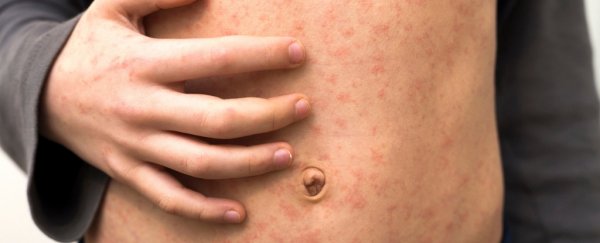The vaccination rate among school children in Texas is slipping to dangerous levels, and public health experts are now warning of a major measles epidemic.
If they're right, it could be one of the largest outbreaks since measles was first declared eliminated in the United States.
"At current vaccination rates, there's a significant chance of an outbreak involving more than 400 people right now in some Texas cities," says David Sinclair an expert in health policy and management at the University of Pittsburgh.
"We forecast that a continuous reduction in vaccination rates would exponentially increase possible outbreak sizes."
These predictions are based on real-world vaccination data, which was plugged into an "agent-based" simulation that runs for the typical length of a school year. This computer model essentially creates a synthetic population that moves around a community in a realistic fashion, from home to work or to school.
Using this tool, the team could predict how a measles contagion might spread from individual to individual within and beyond Texas private and public schools. In fact, this same method was used in California in 2015 to help pass a bill restricting vaccine exemptions for school-age children.
Texas is currently the second largest state by population, and its vaccine exemption laws are some of the least effective in the US. Over the years, as more and more parents choose not to vaccinate for personal or religious reasons, Texan cities both large and small have become increasingly vulnerable to the measles virus.
Experts are worried that if the trend continues and exemptions are not reduced, the risk of a measles outbreak could become exponentially worse.
Since 2003, the number of reported exemptions among Texas students has increased by 28-fold, going from just 2,300 to 64,000 in 2018.
If vaccination rates drop by a further 5 percent, the new research suggests it would increase the size of a potential measles outbreak in some communities by up to 4,000 percent, and could infect nearly a thousand people.
"Efforts to achieve or maintain herd immunity have been hampered by a small segment of the population declining vaccinations for their children for various reasons, including concerns regarding adverse effects of vaccination, lack of knowledge of the vaccine, and social influences," the authors explain.
Running 1,000 simulations for the current Texas vaccination rate and a 5 percent hypothetical decrease, researchers have now shown that a small number of under-vaccinated bubbles can spark a much wider epidemic.
Randomly selecting a student whose parents refused to vaccinated, a single case of measles was introduced into the simulation. This one case was then allowed to spread among others in the community who are vulnerable to the virus.
In Austin and Dallas-Fort Worth alone, where many schools are teetering on a dangerously low vaccination rate, the worst simulations ended up with hundreds of measles cases.
In Dallas-Fort Worth, the authors say there are 13 schools with vaccination rates less than 92 percent, which is the lower end of the herd immunity threshold. In Austin, there are 35 schools who have dropped below this crucial level.
"The simulations suggest that large outbreaks occur where there is a significant population of students for whom a vaccine has been refused; however, infections are not limited to those students," the authors write.
In all the scenarios where more than 25 people became infected, 64 percent of those cases occurred in students whose parents had refused to vaccine them, while 36 percent occurred in innocent bystanders, who either can't be vaccinated or whose vaccinations did not provide full immunity.
When the vaccination rate was decreased by a further 5 percent, the cases skyrocketed. Across the entire state, outbreaks bloomed in every metropolitan area, including Houston, infecting between 500 and a thousand people in just one year.
An outbreak of half a thousand people or more would be unprecedented in the state of Texas and would disproportionately affect children. In 2009 to 2017 in Texas, 60 percent of measles cases occurred in kids younger than 19 years, and the largest of these involved only 25 cases.
William Moss, an epidemiologist at Johns Hopkins who was not involved in the study told Newsweek he was surprised by these extreme results.
"We tend to think in terms of linear relationships, and thus that a 5 percent decrease in vaccination coverage might result in a 5 percent increase in potential outbreak size, but in fact the relationship is exponential," Moss explains.
"This is very important from a public health perspective: small decreases in measles vaccination coverage can have large consequences."
But it's not just Texas that has a problem. The same simulation run in Desoto, Florida, for example, found that if vaccination rates drop by 10 percent, just one case of measles could spread to 800 people.
Today, vaccine exemptions for religious or personal reasons are permissible in 45 states, and in the first five months of this year alone, the US reported 971 cases of measles - the greatest number seen since 1992.
The trend is clear, and if nothing is done to improve vaccination rates or at least stop them from dropping further, many more lives will be put at risk.
"When someone refuses to be vaccinated, they are making a decision that doesn't only impact them," explains Mark Roberts, an expert in health policy and management at Pitt Public Health.
"They are increasing the risk that people who are not immune, through no fault of their own, will get very sick and possibly die."
The findings have been published in Infectious Diseases.
